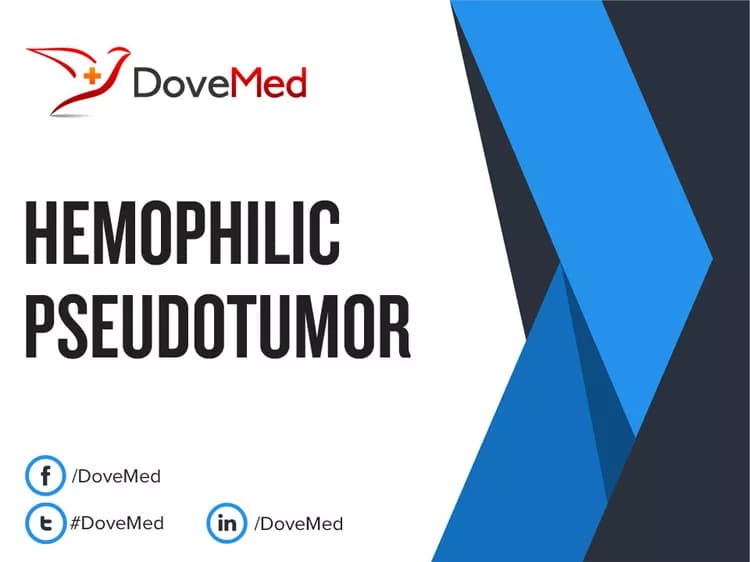
Hemophilic Pseudotumor
What are the other Names for this Condition? (Also known as/Synonyms)
- Hemophilic Cyst of Bone
- Hemophilic Cyst of Soft Tissue
What is Hemophilic Pseudotumor? (Definition/Background Information)
- Hemophilic Pseudotumor is a rare, benign condition of the bone that results in damage to bone or soft tissue caused by hemorrhage in patients, who have been diagnosed with bleeding disorders such as hemophilia
- It is important to note that multiple bleeding episodes within a joint space results in a condition called hemophilic arthropathy, whereas multiple episodes of bleeding into a bone results in Hemophilic Pseudotumor
- This condition almost exclusively occurs in men with a wide age range of 20-70 years being noted. The exact cause of Hemophilic Pseudotumor is unknown
- The signs and symptoms of Hemophilic Pseudotumor may include a slow-growing painful or painless mass, which may be observed in the bones or soft tissues, and pathological fractures seen in the surrounding bones
- A treatment of Hemophilic Pseudotumors may involve controlling the underlying bleeding disorders, radiation therapy, surgical removal of the pseudotumor, and/or embolization
- Complications may develop if the condition is left untreated, such as increased risk of bleeding into the joints, severe degenerative arthritis, and infections
- Currently, there are no definitive ways to prevent formation of this bleeding disorder related condition. Nevertheless, the prognosis of Hemophilic Pseudotumor is good with proper timely diagnosis and suitable treatment
Who gets Hemophilic Pseudotumor? (Age and Sex Distribution)
- About 1 in 100 patients with hemophilia develop Hemophilic Pseudotumor
- However, they typically occur between the ages of 20 and 70 years
- All races and ethnic groups are susceptible to bleeding disorders and they may be affected by Hemophilic Pseudotumors
What are the Risk Factors for Hemophilic Pseudotumor? (Predisposing Factors)
- Due to the increased risk associated with bleeding disorders, Hemophilic Pseudotumors occur almost exclusively in men
It is important to note that having a risk factor does not mean that one will get the condition. A risk factor increases one's chances of getting a condition compared to an individual without the risk factors. Some risk factors are more important than others.
Also, not having a risk factor does not mean that an individual will not get the condition. It is always important to discuss the effect of risk factors with your healthcare provider.
What are the Causes of Hemophilic Pseudotumor? (Etiology)
The cause of formation of Hemophilic Pseudotumor is presently unknown.
What are the Signs and Symptoms of Hemophilic Pseudotumor?
The signs and symptoms of Hemophilic Pseudotumor may include:
- Painful or painless masses: The masses are usually painful, if they compress the surrounding nerves or soft tissues
- Slow-growing cystic masses can occur in the bones or in the surrounding soft tissue
- The pseudotumors usually occur in the lower legs, pelvic bones, and in the buttocks. Rarely, they have been reported in the hands and feet of young individuals
- Pathological fractures of the bone at the site of the tumor may also occur
How is Hemophilic Pseudotumor Diagnosed?
A diagnosis of Hemophilic Pseudotumors may involve:
- Through physical exam with evaluation of complete medical history
- X-rays of the affected region are usually obtained
- Computed tomography (CT) scan, magnetic resonance imaging (MRI) scan of the affected region
- Blood tests to diagnose bleeding disorders are often ordered
- A tissue biopsy of the pseudotumor: Histopathological studies conducted on a biopsy specimen - the specimen is examined under a microscope by a pathologist, to arrive at a definitive diagnosis
- Periodic ultrasound of the cystic mass is helpful in determining, if the pseudotumor is responding to therapy
Many clinical conditions may have similar signs and symptoms. Your healthcare provider may perform additional tests to rule out other clinical conditions to arrive at a definitive diagnosis.
What are the possible Complications of Hemophilic Pseudotumor?
The possible complications from Hemophilic Pseudotumors may include:
- An increased risk of bleeding in the joints: This is known as intra-articular joint hemorrhage, which causes the synovial membrane covering the joints to get inflamed, resulting in reactive synovitis
- Multiple episodes of the aforementioned (joint) hemorrhage can result in degenerative joint disease; repeated bleeding can result in severe degenerative arthritis in the affected joint
- Secondary infections may affect the pseudotumors
In case Hemophilic Pseudotumors remain untreated, the condition can prove to be fatal.
How is Hemophilic Pseudotumor Treated?
The treatment of Hemophilic Pseudotumors may involve the following:
- Controlling the underlying hemophilia
- Suitable treatment measures that are performed to maintain the functioning of the affected limb
- Sometimes, radiation therapy to the region of the mass is performed
- The pseudotumor may be embolized to block off its blood supply. This is called embolization of the pseudotumor
- Complete surgical removal of the pseudotumor followed by filling of the resulting cavity with bone grafts may also be performed
How can Hemophilic Pseudotumor be Prevented?
There is no definitive way to prevent the formation of Hemophilic Pseudotumor. A proper management of underlying hemophilia will decrease the chances of development of this condition.
What is the Prognosis of Hemophilic Pseudotumor? (Outcomes/Resolutions)
The prognosis of Hemophilic Pseudotumor is usually good, with early diagnosis and appropriate treatment.
Additional and Relevant Useful Information for Hemophilic Pseudotumor:
- There are various disorders that may have to be excluded prior to the diagnosis of Hemophilic Pseudotumor including aneurysm bone cyst and osteosarcoma
- Since beginning treatment with recombinant factor VIII, the incidence of Hemophilic Pseudotumor is decreasing
- Individuals who have been treated with recombinant factor VIII, are also living longer, resulting in the possibility of an increased incidence of this bleeding disorder related condition. Under such circumstances, the healthcare providers should consider Hemophilic Pseudotumor in at-risk patients
Related Articles
Test Your Knowledge
Asked by users
Related Centers
Related Specialties
Related Physicians
Related Procedures
Related Resources
Join DoveHubs
and connect with fellow professionals

0 Comments
Please log in to post a comment.